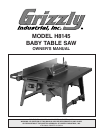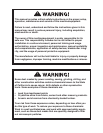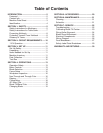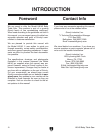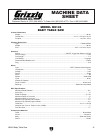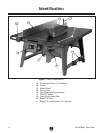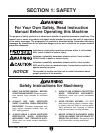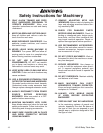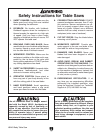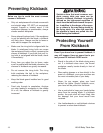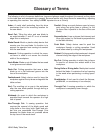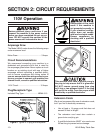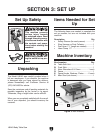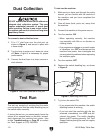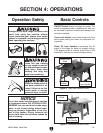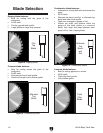
H8145 Baby Table Saw
-7-
Like all machines there is danger associ-
ated with the Model
H8145. Accidents are
frequently caused by lack of familiarity or
failure to pay attention. Use this machine
with respect and caution to lessen the pos
-
sibility of operator injury. If normal safety
precautions are overlooked or ignored, seri
-
ous personal injury may occur.
Safety Instructions for Table Saws
8. CROSSCUTTING LIMITATIONS. DO NOT
crosscut workpieces narrower than 6" with
this machine. Narrow workpieces are dif
-
ficult to properly support when using the
fence as a guide. Instead, use a different
machine that can safely crosscut a narrow
workpiece (miter saw or bandsaw).
9. CUT-OFF PIECES. Stop the blade before
removing cut-off pieces.
10. WORKPIECE SUPPORT. Provide ade
-
quate support to the rear and sides of the
saw table for wide or long workpieces.
11. DAMAGED SAW BLADES. Never use
blades that have been dropped or other-
wise damaged.
12. AVOID DADO, RESAW, AND RABBET
OPERATIONS ON THIS MACHINE.
This
machine is not designed to perform dado or
rabbet cuts. Attempting to make these cuts
on this machine is dangerous. Instead, find
an alternative machine to make these types
of cuts (router or jointer).
13. EXPERIENCING DIFFICULTIES. If at
any time you are experiencing difficulties
performing the intended operation, stop
using the machine! Contact our Technical
Support at (570) 546-9663 for help.
1. SAFETY GUARDS. Always make sure the
blade guard and riving knife are installed
when operating the table saw.
2. KICKBACK. Be familiar with kickback.
Kickback happens when the workpiece is
thrown towards the operator at a high rate
of speed. Until you have a clear under
-
standing of kickback and how it occurs, DO
NOT operate this table saw!
3. REACHING OVER SAW BLADE. Never
reach behind or over the blade while the saw
is running. Hands or arms could be pulled
into the saw blade if kickback occurs.
4. WORKPIECE CONTROL. Make sure the
workpiece is stable on the table and is sup
-
ported by the rip fence or the miter sled
during cutting operations. DO NOT perform
any cutting operations free-hand.
5. SAFETY ACCESSORIES. Use push sticks,
hold-downs, featherboards, and other
devices to increase cutting safety.
6. OPERATOR POSITION. Never stand or
have any part of your body directly in-line
with the cutting path of the saw blade.
7. HAND POSITIONING. Avoid operations
and hand positions where a slip could
cause your hand to move into the blade.
No list of safety guidelines can be complete.
Every shop environment is different. Always
consider safety first, as it applies to your
individual working conditions. Use this and
other machinery with caution and respect.
Failure to do so could result in serious per-
sonal injury, damage to equipment, or poor
work results.



